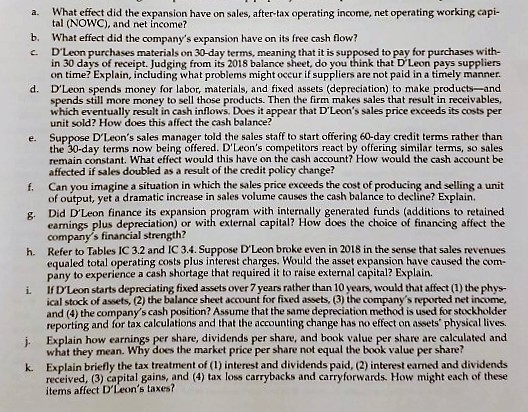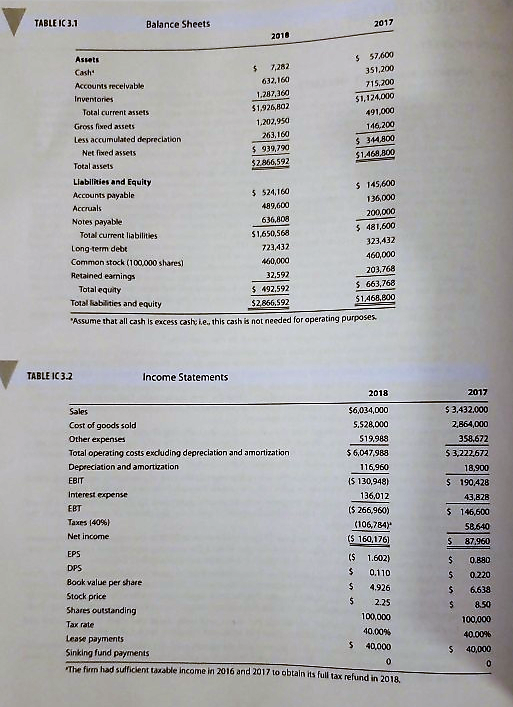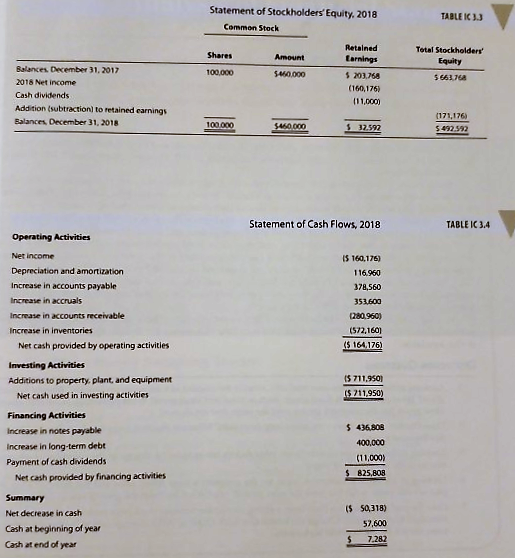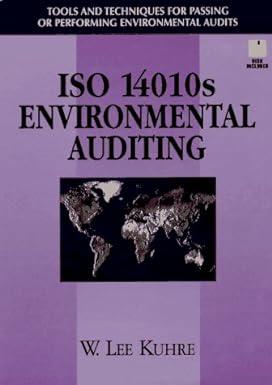Integrated Case- Part 1 (Ch. 3)
Donna Jamison, a 2011 graduate of University of Florida with 4 years of banking experience, was recently brought in as assistant to chairperson of the board of DLeon Inc., a small food producer that operates in north Florida and whose specialty is high-quality pecan and other nut products sold in the snack foods market. DLeons president, Al Watkins decided in 2017 to undertake a major expansion and to go national in competition with Frito-Lay, Eagle, and other major snack foods companies. Watkins believe the DLeons products were of higher quality than the competitions, that this differential would enable it to charge a premium price, and that the end result would be greatly increase sales, profits, and stock price.
The company doubled its plant capacity, opened new sales offices outside its home territory, and launched an expensive advertising campaign. DLeons results were not satisfactory, to put it mildly. Its board of directors, which consisted of its president, vice president, and major stockholders (all of whom were local businesspeople), was most upset when directors learned how the expansion was going. Unhappy suppliers were being paid late, and the bank was complaining about the deteriorating situation and threatening to cut off credit. As a result, Watkins was informed that changes would have to be made-and quickly; otherwise, he would be fired. Also, at the boards insistence, Donna Jamison was brought in and given the job of assistant to Fred Campo, a retired banker who was DLeons chairperson and largest stockholder. Campo agreed to give up a few of his golfing days and help nurse the company back to health, with Jamisons help.
Jamison began by gathering the financial statements and other data given in the tables below. Assume that you are Jamisons assistant. You must help her answer the following questions for Campo.
Answer questions A-K; use the tables below.



What effect did the expansion have on sales, after-tax operating income, net operating working capi- tal (NOwC), and net income? a. b. c. D'Leon purchases materials on 30-day terms, meaning that it is supposed to pay for purchases with- What effect did the company's expansion have on its free cash flow? in 30 days of receipt. Judging from its 2018 balance sheet, do you think that D'Leon pays suppliers on time? Explain, including what problems might oceur if suppliers are not paid in a timely manner D'Leon spends money for labor, materials, and fixed assets (depreciation) to make products-and spends still more money to sell those products. Then the firm makes sales that result in receivables, d. hich eventually result in cash inflows. Does it appear that D'Leon's sales price exceeds its costs per unit sold? How does this affect the cash balance? e. Suppose D'Leon's sales manager told the sales staff to start offering 60-day credit terms rather than ay terms now being offered. D'Leon's competitors react by offering similar terms, so sales remain constant. What effect would this have on the cash account? How would the cash account be affected if sales doubled as a result of the credit policy change? f. Can you imagine a situation in which the sales price exceeds the cost of producing and selling a unit of output, yet a dramatic increase in sales volume causes the cash balance to decline? Explain Did D'Leon finance its expansion program with internally generated funds (additions to retained earnings plus depreciation) or with external capital? How does the choice of financing affect the company's financial strength? g. h. Refer to Tables IC 3.2 and IC 3.4. Suppose D'Leon broke even in 2018 in the sense that sales revenues equaled total operating costs plus interest charges. Would the asset expansion have caused the com pany to experience a cash shortage that required it to raise external capital? Explain i. IfD'Leon starts depreciating fixed assets over 7 years rather than 10 years, would that affect (1) the phys- ical stock of assets, (2) the balance sheet account for fixed assets, (3) the company's reported net income, and (4) the company's cash position? Assume that the same depreciation method is used for stockholder reporting and for tax calculations and that the accounting change has no effect on assets' physical lives Explain how earnings per share, dividends per share, and book value per share are calculated and what they mean. Why does the market price per share not equal the book value per share? Explain briefly the tax treatment of (1) interest and dividends paid, (2) interest earned and dividends received, (3) capital gains, and (4) tax loss carrybacks and carryforwards. How might each of these items affect D'Leon's taxes? j. k. TABLE IC 3.1 Balance Sheets 2017 2018 Assets Cash Accounts recelvable nventories 7282 632,160 1,287,360 $1.926R02 1,202,950 263,160 939,790 $2866,592 57600 351,200 715,200 $1,124000 491,000 146,200 344800 Total current assets Gross fixed assets Less accumulated depreciation Net fixed assets Total assets Liabilities and Equity Accounts payable S 145,600 136,000 200,000 5 481,600 323,432 460,000 203,768 663,768 51468,800 5 524,16 489,600 636,808 1,650,568 723,432 460,000 32,592 492.592 $2,866,592 Accruals Notes payable Total current liabllities Long term debt Common stock (100,000 shares) Retained earnings Total equity Total ablities and equity Assume that all cash is excess cashe Le., thls cash is not needed for operating purposes TABLE IC3.2 Income Statements 2018 $6,034,000 5.S28,000 2017 $3.432.000 2,864,000 Sales Cost of goods sold Other expenses Total operating costs exduding depreciation and amortization Depreciation and amortization EBIT Interest epense EBT Taxes 140%) Net income EPS DPS Book value per share Stock price Shares outstanding Tax rate Lease payments Sinking fund payments 358,672 6,047,988 116,960 IS 130,948) 136,012 S 266,960) 106,784 5 3,222672 18,900 S 190.428 43,828 146,600 58.540 S 87.960 S 1.602) $ 0.110 S 4926 2.25 100,000 40,00% S AD,000 0.880 5 0.220 6.638 $ 850 100,000 40006 $ 40,000 5 The firm had sufficlent t taxable income in 2016 and 2017 to obtaln its full tax refund in 2018 Statement of Stockholders Equity. 2018 TABLE IC 33 Common Stock Retained tarnings Total Stockholders Equity Shares Amount Balances December 31, 2017 2018 Net income Cash dividends Addition (subtraction) to retained carnings Balances December 31, 2018 100,000 5460,000 203,768 (160,176 11,0000 5663.768 100000 460000 s 492.59 Statement of Cash Flows, 2018 TABLE IC 3.4 Operating Activities Net income Depreciation and amortization Increase in accounts payable Increase in accruals Increase in accounts receivable Increase in inventories 160,176) 116.960 378,560 353.600 280,960) (572,160) $ 164,176) Net cash provided by operating activities Additions to property. plant, and equipment ($ 711,950 711,950) Net cash used in investing activities 436809 increase in notes payable Increase in long-term debt Payment of cash dividends 400,000 11,000) 825,808 Net cash provided by financing activities Summary Net decrease in cash Cash at beginning of year Cash at end of year S 50,318) 57,600 7.282









